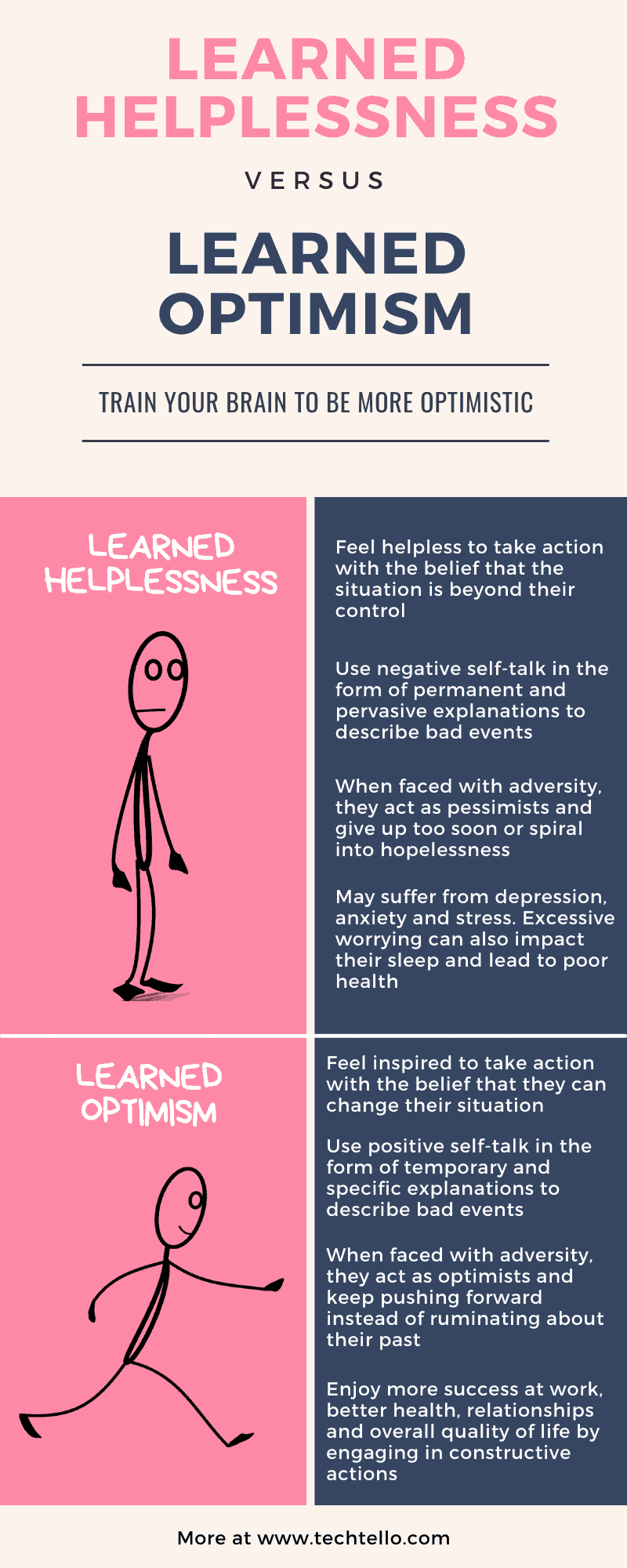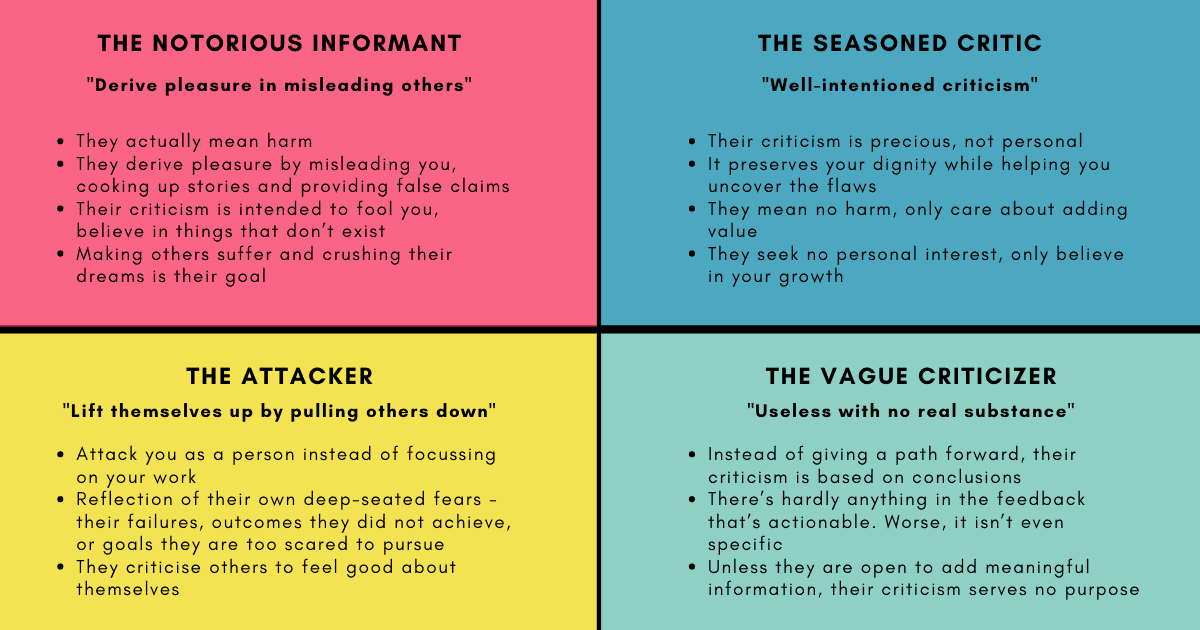Learned Helplessness vs Learned Optimism: How To Train Your Brain To Be More Optimistic

We have all heard about the pessimist who gives up easily and the optimist who perseveres in the face of failures. When faced with adversity, most people feel indecisive, restless, and anxious about the future. It is what happens afterward that makes a difference – an optimist is briefly disturbed by the experience, but soon bounces back while a pessimist continues to be paralyzed by fear of failure. An optimist storms out of this phase with the belief that it’s only a rough patch while the pessimist spirals into hopelessness with the belief in the permanent nature of their situation.
You can distinguish an optimist from a pessimist in the way they speak to themselves:
- When struggling with something hard, an optimist would say “Wow, this is hard. I have to put in more effort!” while a pessimist would say “Wow, this is hard. I don’t have what it takes!”
- When reflecting back on their mistakes, a pessimist might say “I’m a loser, I can’t seem to get anything right” while an optimist might think “Why did I make this mistake. What does this mistake teach me? How can I do better next time.”
- When dealing with criticism, an optimist will go beyond words to the intent of the message and consider it as an opportunity to improve. They tend to think “How can I cut through the noise to find value in this feedback.” A pessimist might consider criticism as an attack on their identity. They tend to think “If the person is saying so, it must be right. This criticism is a sign that I will never succeed. I must give up now.”
- While making a difficult decision, an optimist is more likely to think big and believe in their decision while a pessimist will continue to question their judgment instead of investing in making their idea successful. An optimist would say “I can make this idea successful” while a pessimist would say “This is going to fail.”
Research shows that optimism enhances the quality of life. Optimists are more successful at work, have better relationships, better health, and also enjoy a better quality of life. Optimism not only helps you get past many difficulties and challenges that life throws your way by engaging in constructive actions instead of destructive behaviors but also helps you realize that not everything in life will go according to plan. Accepting just that is a big part of moving forward. What does this mean? You are better prepared to handle adversity when it strikes instead of feeling knocked down and collapse into mental distress.
Are people born as optimists or pessimists or can anyone learn to be resilient and use difficult experiences as a catalyst for growth?
“You will come across obstacles in life — fair and unfair. And you will discover, time and time again, that what matters most is not what these obstacles are but how we see them, how we react to them, and whether we keep our composure. You will learn that this reaction determines how successful we will be in overcoming — or possibly thriving because of — them. Where one person sees a crisis, another can see opportunity. Where one is blinded by success, another sees reality with ruthless objectivity. Where one loses control of emotions, another can remain calm. Desperation, despair, fear, powerlessness—these reactions are functions of our perceptions. You must realize: Nothing makes us feel this way; we choose to give in to such feelings,” says Ryan Holiday in The Obstacle Is the Way.
The environment in which someone is raised sows the seeds of their behavior, the culture they adopt influences their thinking, and the people they choose to engage with shapes up their identity. Their personality and behavior isn’t set in stone, it’s actually quite malleable. Anyone can learn to be an optimist by changing their mindset and adopting the right practices.
How people learn to be helpless
Martin Seligman, father of modern positive psychology conducted experiments way back in 1964 that proved how people learn to feel helpless. Angela Duckworth describes this experiment on learned helplessness in her book Grit.
A caged dog receives electric shocks to its back paws. The shocks come randomly and without warning. If the dog does nothing, the shock lasts five seconds, but if the dog pushes its nose against a panel at the front of the cage, the shock ends early. In a separate cage, another dog receives the same shocks at exactly the same intervals, but there’s no panel to push on. In other words, both dogs get the exact same dosage of shock at the exact same times, but only the first dog is in control of how long each shock lasts. After sixty-four shocks, both dogs go back to their home cages, and new dogs are brought in for the same procedure.
The next day, one by one, all the dogs are placed in a different cage called a shuttle box. In the middle, there’s a low wall, just high enough that the dogs can leap the barrier if they try. A high-pitched tone plays, heralding an impending shock, which comes through the floor of the half of the shuttle box where the dog is standing. Nearly all the dogs who had control over the shocks the previous day learn to leap the barrier. They hear the tone and jump over the wall to safety. In contrast, two-thirds of the dogs who had no control over the shocks the previous day just lie down whimpering, passively waiting for the punishment to stop.
Human beings tend to behave the same way as published in this 1975 experiment by Donald Hiroto and Martin Seligman –
People are randomly divided into three groups. People in the first group are exposed to an annoying loud noise that they can stop by pushing a button in front of them. People in the second group hear the same noise but can’t turn it off, though they try hard and people in the third group, the control group, hear nothing at all. The following day, the subjects are faced with a brand-new situation that again involves noise. To turn the noise off, all they have to do is move their hands about 12 inches. The people in the first and third groups figure this out and readily learn to avoid the noise. But those in the second group typically do nothing. In phase one they failed, realized they had no control, and became passive. In phase two, expecting more failure, they don’t even try to escape. They have learned helplessness.
Strangely, however, about a third of the animals and people who experience inescapable shocks or noise never become helpless. What is it about them that makes this so?
Martin’s study concluded that the answer is optimism. He showed that it is not suffering that leads to hopelessness, it’s the suffering you believe that you can’t control. While pessimists feel helpless because they think the situation is beyond their control and refuse to do anything to change it, the optimists do everything in their power to take control of their situation. Adversity doesn’t define them, it is one of the engines to fuel their growth.
Learned optimism is the path to building resilience
While two-thirds of the dogs gave up, what was about these one-thirds of dogs who remained resilient despite their earlier trauma? Further research on the topic of resilience led Martin Seligman to study the “I quit response” to adversity in people. Out came Learned optimism.
He found that “pessimists” attach permanent and pervasive explanations to bad events – permanence signifying that you can’t do much about them and pervasive in that one single event can influence a large part of your life. Permanent and pervasive explanations turn minor events into major setbacks and these people gravitate towards “I quit attitude.”
On the other end, optimists use temporary and specific explanations to describe bad events – temporary explanations motivate them to put effort into fixing their problems and specificity keeps the focus of the problem on that particular event without generalizing it. Temporary and specific explanations drive clarity and encourage problem-solving. Such people learn to take control of their situation and don’t feel helpless.
“Emotions and actions do not usually follow adversity directly. Rather they issue directly from your beliefs about adversity. This means that if you change your mental response to adversity, you can cope with setbacks much better,” says Martin Seligman in Learned Optimism.
Pessimists can learn to be optimists by thinking about their reactions to adversity in a new way using learned optimism. Learned optimism is the idea in positive psychology that states that optimism can be learnt by challenging the negative self-talk. It requires shifting from negative self-talk in the form of permanent and pervasive interpretations to positive self-talk using temporary and specific explanations.
Let’s say you missed a deadline to deliver a project. Instead of saying “I’m a loser! I screw up everything!” challenge your thinking and choose more likely explanations “I did not manage my time well. I could have been less distracted. I can procrastinate less and start earlier.” Think about the recent events in your life – fight with a coworker, losing a deal, missing a sales target, not getting promoted, receiving criticism for your work, losing a client, and so on. What language did you use to describe these events?
Your beliefs shape your mindset. The way you talk to yourself plays a key role in how you lead your life and whether you succeed in your goals. Shift from learned helplessness to learned optimism by catching yourself in negative thoughts and disputing them with more positive and hopeful thoughts. To do this – take note of your emotions and whenever you sense going down a negative path, reframe it using a more positive tone. Use language that describes the event as temporary and specific, hence fixable as opposed to a permanent and pervasive explanation with a feeling of hopelessness.
When you make mistakes, instead of saying “I can’t do anything right” choose to say “I made a mistake. I can fix it.” When you struggle through a task, instead of saying “I don’t have what it takes”, choose to say “I can figure this out.”
Saying is believing. If you keep telling yourself that you can’t do something, ultimately your brain will believe it. Don’t let your negative self-talk become a self-fulfilling prophecy.
Self-Compassion Workbook
Cultivate kindness and strength in the face of difficulty and foster a new, more gentle and loving perspective on your struggles.
Summary:
People with learned Helplessness:
- Feel helpless to take action with the belief that the situation is beyond their control.
- Use negative self-talk in the form of permanent and pervasive explanations to describe bad events.
- When faced with adversity, they act as pessimists and give up too soon or spiral into hopelessness.
- May suffer from depression, anxiety and stress. Excessive worrying can also impact their sleep and lead to poor health.
People with learned Optimism:
- Feel inspired to take action with the belief that they can change their situation.
- Use positive self-talk in the form of temporary and specific explanations to describe bad events.
- When faced with adversity, they act as optimists and keep pushing forward instead of ruminating about their past.
- Enjoy more success at work, better health, relationships and overall quality of life.






























